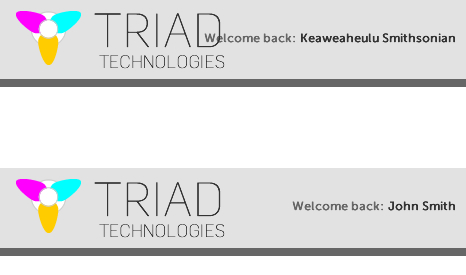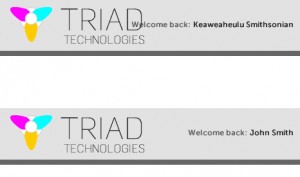
I frequently come across designs that use placeholders, as this is a common practice in the design industry. I think we’re all familiar with “lorem ipsum” and “John Doe.” Those work well in most cases for filler and/or placeholder content, but can wreak havoc in your design once it goes into actual production and all of a sudden you realize that the data providing your content is about 100 words vs. the 20 you designed for and the names contain a lot more characters than John Doe, which now disrupts your design and things aren’t looking so pretty anymore when the label or greeting is being pushed into the logo of the header, because “John Doe” is now “Keaweaheulu Smithsonian.”

Now, that’s only about 15 characters more than the placeholder, but it could have a huge impact on the design if not thought out properly. It is a fundamental mistake that occurs often and sometimes isn’t discovered until further into the process and can cause a domino effect in your design.
This post isn’t just about long names or words, this philosophy should be applied to the whole design overall, from text handling to containers, lists, etc.
In the interactive realm, considerations for multiple screen sizes has been around for years, but it is more important now than ever with all of the devices popping up every other week. Making sure that your design fits the screen it is being displayed on is key, but making sure the content that is being displayed is usable and valuable is even more important; you can’t just truncate everything, that’s just a copout.
Any aspect of your design that will contain content, especially dynamic data that you may not have a lot of control over, needs to be considered in a “worse case scenario” presentation. It may not look pretty and when most designs are being created, it is preferred to have a nice and pretty best case scenario or the “happy path” view, especially if you are presenting to a client. I don’t disagree, but the design should consider those other scenarios be it edge case or not. And if it is so edge case that the probability is almost 0 that means it isn’t impossible, thus there still needs to be a rule and design to define what would happen under those circumstances, as it will go into development and code will have to instruct the UI on what to do and how to handle content.
You don’t have to show that worse case scenario design to the client if isn’t ideal or required, but at least you know that you have taken the time to plan and have a viable solution for it when and if it occurs. If you can make that scenario look good, then more power to you and your design has probably been well thought out to handle scalability without much impact to the integrity of the design.
In short, as much as placeholder data is easy to throw in and efficient, make sure your placeholder content mimics the real world data as much as possible and always throw in that wild card like the Hawaii state fish, Humuhumunukunukuapuaa, just to see how well your design will handle a scenario around that.